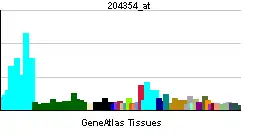POT1
POT1 (del inglés protection of telomeres 1, «protección de telómeros 1») caracterizada por primera vez en S. pombe, es un gen humano.[1]
Su función es estabilizar el "D-loop" (bucle D), evitando así que el extremo 3' del telómero del cromosoma (el cual es un poco más largo que el 5') active mecanismos de reparación del ADN, lo cual sucedería si estuviera expuesta la monohebra.
Este gen es miembro de la familia de la telombina y codifica una proteína nuclear implicada en el mantenimiento de los telómeros. Específicamente, esta proteína funciona como miembro de un complejo multiproteico llamado telosoma que se une a las repeticiones TTAGGG de los telómeros, regulando su longitud y protegiendo a los extremos del cromosoma de recombinación ilegítima, inestabilidad cromosómica catastrófica y segregación cromosómica anormal. Se asocia un aumento anormal de la expresión en la transcripción con la carcinogénesis gástrica y su progresión. Se han descrito variantes por splicing alternativo.[1]
Bibliografía
- de Lange T (2005). «Shelterin: the protein complex that shapes and safeguards human telomeres.». Genes Dev. 19 (18): 2100-10. PMID 16166375. doi:10.1101/gad.1346005.
- Bonaldo MF, Lennon G, Soares MB (1997). «Normalization and subtraction: two approaches to facilitate gene discovery.». Genome Res. 6 (9): 791-806. PMID 8889548.
- Baumann P, Cech TR (2001). «Pot1, the putative telomere end-binding protein in fission yeast and humans.». Science 292 (5519): 1171-5. PMID 11349150. doi:10.1126/science.1060036.
- Baumann P, Podell E, Cech TR (2002). «Human Pot1 (protection of telomeres) protein: cytolocalization, gene structure, and alternative splicing.». Mol. Cell. Biol. 22 (22): 8079-87. PMID 12391173.
- Strausberg RL, Feingold EA, Grouse LH, et al. (2003). «Generation and initial analysis of more than 15,000 full-length human and mouse cDNA sequences.». Proc. Natl. Acad. Sci. U.S.A. 99 (26): 16899-903. PMID 12477932. doi:10.1073/pnas.242603899.
- Loayza D, De Lange T (2003). «POT1 as a terminal transducer of TRF1 telomere length control.». Nature 423 (6943): 1013-8. PMID 12768206. doi:10.1038/nature01688.
- Colgin LM, Baran K, Baumann P, et al. (2004). «Human POT1 facilitates telomere elongation by telomerase.». Curr. Biol. 13 (11): 942-6. PMID 12781132.
- Hillier LW, Fulton RS, Fulton LA, et al. (2003). «The DNA sequence of human chromosome 7.». Nature 424 (6945): 157-64. PMID 12853948. doi:10.1038/nature01782.
- Ota T, Suzuki Y, Nishikawa T, et al. (2004). «Complete sequencing and characterization of 21,243 full-length human cDNAs.». Nat. Genet. 36 (1): 40-5. PMID 14702039. doi:10.1038/ng1285.
- Loayza D, Parsons H, Donigian J, et al. (2004). «DNA binding features of human POT1: a nonamer 5'-TAGGGTTAG-3' minimal binding site, sequence specificity, and internal binding to multimeric sites.». J. Biol. Chem. 279 (13): 13241-8. PMID 14715659. doi:10.1074/jbc.M312309200.
- Kondo T, Oue N, Yoshida K, et al. (2004). «Expression of POT1 is associated with tumor stage and telomere length in gastric carcinoma.». Cancer Res. 64 (2): 523-9. PMID 14744765.
- Armbruster BN, Linardic CM, Veldman T, et al. (2004). «Rescue of an hTERT mutant defective in telomere elongation by fusion with hPot1.». Mol. Cell. Biol. 24 (8): 3552-61. PMID 15060173.
- Liu D, Safari A, O'Connor MS, et al. (2004). «PTOP interacts with POT1 and regulates its localization to telomeres.». Nat. Cell Biol. 6 (7): 673-80. PMID 15181449. doi:10.1038/ncb1142.
- Ye JZ, Hockemeyer D, Krutchinsky AN, et al. (2004). «POT1-interacting protein PIP1: a telomere length regulator that recruits POT1 to the TIN2/TRF1 complex.». Genes Dev. 18 (14): 1649-54. PMID 15231715. doi:10.1101/gad.1215404.
- Gerhard DS, Wagner L, Feingold EA, et al. (2004). «The status, quality, and expansion of the NIH full-length cDNA project: the Mammalian Gene Collection (MGC).». Genome Res. 14 (10B): 2121-7. PMID 15489334. doi:10.1101/gr.2596504.
- Lei M, Podell ER, Cech TR (2005). «Structure of human POT1 bound to telomeric single-stranded DNA provides a model for chromosome end-protection.». Nat. Struct. Mol. Biol. 11 (12): 1223-9. PMID 15558049. doi:10.1038/nsmb867.
- Veldman T, Etheridge KT, Counter CM (2005). «Loss of hPot1 function leads to telomere instability and a cut-like phenotype.». Curr. Biol. 14 (24): 2264-70. PMID 15620654. doi:10.1016/j.cub.2004.12.031.
- Kelleher C, Kurth I, Lingner J (2005). «Human protection of telomeres 1 (POT1) is a negative regulator of telomerase activity in vitro.». Mol. Cell. Biol. 25 (2): 808-18. PMID 15632080. doi:10.1128/MCB.25.2.808-818.2005.
- Yang Q, Zheng YL, Harris CC (2005). «POT1 and TRF2 cooperate to maintain telomeric integrity.». Mol. Cell. Biol. 25 (3): 1070-80. PMID 15657433. doi:10.1128/MCB.25.3.1070-1080.2005.
- Lei M, Zaug AJ, Podell ER, Cech TR (2005). «Switching human telomerase on and off with hPOT1 protein in vitro.». J. Biol. Chem. 280 (21): 20449-56. PMID 15792951. doi:10.1074/jbc.M502212200.


